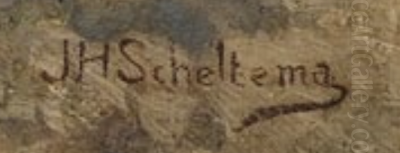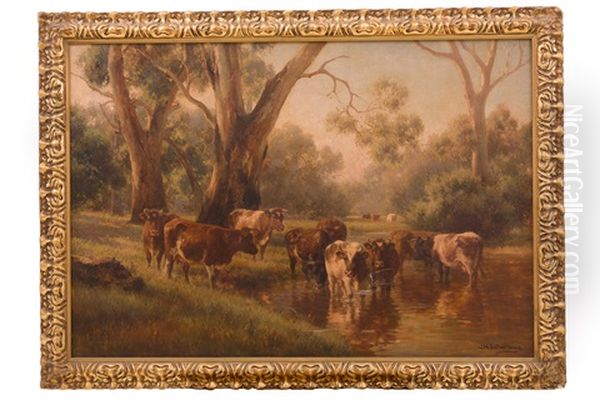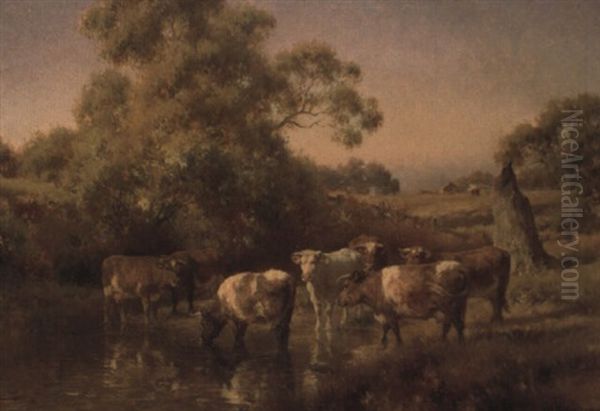
Jan Hendrik Scheltema stands as a significant figure bridging the artistic traditions of the Netherlands and Australia. Born in the Netherlands in 1861 and passing away in Australia in 1941, his life and work represent a fascinating journey from the established art academies of Europe to the burgeoning art scene and distinctive landscapes of his adopted homeland. Primarily celebrated for his evocative pastoral scenes, particularly those featuring cattle, Scheltema carved a unique niche for himself, blending his Dutch training with a keen observation of Australian rural life and light. His work continues to be appreciated for its technical skill, atmospheric quality, and contribution to the depiction of the Australian pastoral identity.
Early Life and Artistic Formation in the Netherlands
Jan Hendrik Scheltema's artistic journey began in The Hague, Netherlands, where he was born in 1861. His formal art education took place between 1880 and 1884, a period during which he demonstrated considerable promise. This talent was recognized at the highest level when he was awarded a prestigious scholarship by King William III of the Netherlands. This royal patronage enabled him to pursue his studies at the renowned art academies in both The Hague and Antwerp, Belgium. These institutions were vital centres of artistic learning, steeped in the traditions of European art but also responsive to contemporary movements.
During his formative years in Europe, Scheltema initially focused on figure painting and portraiture, skills that would underpin his later work. He also engaged with landscape painting, a genre deeply ingrained in Dutch art history. His training occurred during a period when the Hague School was a dominant force in Dutch art. Artists like Jozef Israëls, Anton Mauve (a cousin-in-law of Vincent van Gogh), the Maris brothers (Jacob, Matthijs, and Willem), Johan Hendrik Weissenbruch, and Hendrik Willem Mesdag were renowned for their realistic and atmospheric depictions of Dutch landscapes, peasant life, and coastal scenes. Scheltema absorbed these influences, developing a sensitivity to light, tone, and the everyday realities of rural existence.

Sources also mention a teacher named Bertelman playing a role in his development. This likely refers to Johannes Anthonie Balthasar Bertelman, a Dutch painter and educator active during that period. Close mentorship, like the kind suggested by records of illustrated correspondence between Scheltema and Bertelman, was crucial for young artists. This early grounding in Dutch realism and the tonal subtleties favoured by the Hague School provided Scheltema with a strong technical foundation and a specific way of seeing the world, which he would later adapt to a vastly different environment.
Emigration and a New Beginning in Australia
In 1888, seeking new opportunities or perhaps drawn by the allure of a distant continent, Jan Hendrik Scheltema made the life-changing decision to emigrate to Australia. This move marked a significant turning point in his career and personal life. He chose to settle in Melbourne, Victoria, which was then a vibrant hub of artistic activity in Australia. The city was home to a growing community of artists and institutions, providing a supportive environment for a newcomer with solid European training.
Upon establishing himself in Melbourne, Scheltema did not solely rely on selling his paintings. He also took up teaching, offering instruction in painting and drawing. This role would have connected him with local aspiring artists and helped him integrate into the Melbourne art community. Teaching often provides artists with a steady income stream while allowing them to continue their own practice, and it likely served this purpose for Scheltema as he navigated his new surroundings and established his reputation.
His arrival coincided with a particularly dynamic period in Australian art history. The artists associated with the Heidelberg School, including Tom Roberts, Frederick McCubbin, Arthur Streeton, and Charles Conder, were actively forging a distinctively Australian style of landscape painting, often characterized by a brighter palette and a focus on capturing the unique effects of Australian light and depicting national narratives. Scheltema, arriving with his Dutch sensibilities, would operate alongside, rather than strictly within, this movement, bringing his own perspective to the Australian scene.
Artistic Style: Dutch Roots in an Australian Context
Scheltema's artistic identity in Australia became strongly associated with pastoral landscapes and, most notably, the depiction of livestock, particularly cattle. While his early European work included portraits and broader landscapes, his Australian oeuvre is dominated by scenes of rural life, droving, grazing herds, and farm activities set within the Victorian countryside. This focus distinguished him somewhat from the Heidelberg School artists, who, while painting landscapes, often emphasized plein-air techniques, specific light effects, and sometimes nationalistic themes more overtly.

His style retained elements of his Dutch training, particularly the tonalism and atmospheric sensitivity characteristic of the Hague School. Unlike the broken brushwork and high-keyed colour often associated with French Impressionism, Scheltema's approach often involved more blended tones, a careful rendering of form (especially in his animals), and a focus on the overall mood and atmosphere of a scene. He showed a remarkable ability to capture the textures of animal hides, the dust kicked up by hooves, and the specific quality of light in the Australian bush, albeit often rendered with a subtlety perhaps informed by the softer light of his homeland.
He became a master of depicting cattle, not just as landscape elements, but as subjects possessing weight, movement, and individual character. His compositions often feature herds moving through the landscape, gathered at waterholes, or being overseen by stockmen, conveying a sense of the daily rhythms of pastoral life. While working alongside Australian Impressionists like Roberts, McCubbin, Streeton, and Walter Withers, Scheltema maintained his unique voice, influenced perhaps by earlier Australian landscape painters like Louis Buvelot, but ultimately defined by his fusion of Dutch tradition and Australian subject matter. His work offered a different, perhaps more grounded and less overtly nationalistic, vision of the Australian landscape compared to some of his contemporaries.
Representative Works and Recognition
Jan Hendrik Scheltema's reputation rests firmly on his numerous depictions of Australian pastoral life. Among his well-known and representative works is Overseeing the Herd. This title, and variations like Driving the Herd, Returning Home, or Milking Time, encapsulate the core themes of his output. These paintings typically showcase his skill in rendering cattle with anatomical accuracy and conveying the atmosphere of the Victorian landscape – the dusty plains, the eucalyptus trees, the specific quality of sunlight or twilight. His ability to capture the collective movement of a herd or the quietude of animals resting near water demonstrates his deep observation and technical proficiency.
His work found favour with the public and institutions alike. Scheltema exhibited his paintings, and they were acquired by major public collections across Australia. Today, his works are held in prestigious institutions such as the Art Gallery of New South Wales (Sydney), the Art Gallery of South Australia (Adelaide), the National Gallery of Victoria (Melbourne), and the National Gallery of Australia (Canberra). This widespread representation in national and state galleries underscores his importance in the narrative of Australian art history.
Beyond public galleries, Scheltema's paintings have remained popular in the art market. His works frequently appear at auction, fetching respectable prices and demonstrating continued collector interest. Auctions held by firms like Phillip Caldwell Auctioneers and appearances in sales featuring decorative arts from Victorian mansions confirm the enduring appeal of his pastoral scenes. Furthermore, institutions like the Gippsland Art Gallery have actively promoted his work, even utilizing modern methods like online exhibitions and virtual 360-degree tours to bring his art to wider audiences, ensuring his contribution is not forgotten. His participation in events like the "Five Dutch Days" celebration at Art Break Gallery Brooklyn in 2009 also highlights occasional international recognition.
Connections, Context, and Rediscovered Correspondence
Scheltema's life in Australia involved interactions with the local art community and connections back to his Dutch heritage. An interesting anecdote reveals something of his professional principles and perhaps his relationship with the established art world. He was reportedly invited by the Dutch Consul-General in Australia to join a committee tasked with facilitating the import of Dutch art into the country. This initiative specifically mentioned bringing works by prominent artists, including the celebrated Hague School painter Jozef Israëls, whom Scheltema would have known by reputation, if not personally, from his time in the Netherlands.
Intriguingly, Scheltema declined the invitation. His reasoning, as recorded, was twofold. He expressed a belief that, as an artist working in Australia, his primary loyalty should be to support local artists. He also made a cryptic reference to the experiences of the Koekkoek family (a famous dynasty of Dutch painters, perhaps Hermanus Koekkoek Sr. or Jr.), suggesting that repeating whatever path they took regarding international art dealings was not something he wished to do. This incident paints a picture of an artist navigating the complexities of cultural identity and professional networks, asserting his position within his adopted country.
Further insight into Scheltema's life, thoughts, and connections has emerged more recently through a significant archival discovery. In early 2019, a substantial collection of his handwritten letters, amounting to over 800 pages, was found. These letters, primarily addressed to his family back in the Netherlands, provide an invaluable window into his experiences as an immigrant artist in Australia. Now housed in the State Library of Victoria, these documents complement other correspondence held in Dutch archives. They detail not only his artistic endeavours but also his personal life, his observations about Australia, and his enduring ties to his homeland, enriching our understanding of the man behind the paintings. The correspondence with his teacher Bertelman, featuring illustrations, further highlights the personal connections that sustained him.
Later Life and Enduring Legacy
Jan Hendrik Scheltema fully embraced his adopted country, becoming an Australian citizen in 1935, nearly five decades after his arrival. He continued to paint and contribute to the Australian art scene throughout his later years. His life journey concluded in Brisbane, Queensland, where he passed away in 1941 at the age of 80.
His legacy is that of a highly skilled and dedicated painter who successfully translated his European training into a meaningful engagement with the Australian environment. He holds a distinct place in Australian art history as one of the foremost painters of cattle and pastoral scenes during the late 19th and early 20th centuries. While perhaps not as focused on the grand national narratives as some Heidelberg School figures, his work offered an authentic and deeply felt portrayal of the working rural landscape, resonating with Australia's strong pastoral identity.
Scheltema's contribution can be seen as complementary to that of his Australian contemporaries. While artists like Roberts and Streeton captured the heroic aspects of bush life or the dazzling effects of antipodean light, Scheltema focused on the rhythms and realities of pastoralism with a quiet dignity and atmospheric depth rooted in his Dutch background. He stands alongside other significant figures who depicted the Australian landscape and rural life, such as Walter Withers or later artists like Hans Heysen (though Heysen's focus shifted more towards the monumental forms of gum trees and the Flinders Ranges). Scheltema's consistent output and the presence of his work in major collections ensure his continued recognition. He remains an important figure for understanding the diverse influences that shaped Australian art and serves as a key example of the successful integration of European artistic traditions into the Australian context.
Conclusion
Jan Hendrik Scheltema's career represents a successful fusion of two worlds. Trained in the rich artistic milieu of the Netherlands, influenced by the tonal realism of the Hague School, he transplanted his skills and sensibilities to Australia. There, he became a preeminent painter of the pastoral scene, capturing the essence of rural Victoria, particularly its cattle stations, with remarkable skill and sensitivity. His works, found in major Australian galleries and appreciated by collectors, stand as a testament to his dedication and unique artistic vision. More than just a painter of cows, Scheltema was an artist who chronicled a significant aspect of Australian life and landscape, leaving behind a body of work that continues to evoke the atmosphere and character of the bush, viewed through a distinctive Dutch-Australian lens. His life and art serve as an enduring bridge between the artistic heritage of the Netherlands and the cultural landscape of Australia.